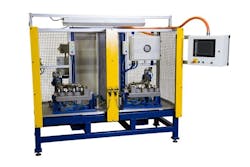Over the past decade, manufacturers in virtually every market have seen machines stand idle and floor space go unused during the economic downturn. Today, as the recovery accelerates, companies are understandably reluctant to invest in new capital and facilities. Our clients are challenged today with growing their business while optimizing existing staff, machinery, and facilities. Our team has focused a great deal on designing and building systems that integrate processes and machines. We’ve largely done this by creating machines that incorporate the functionality of multiple configurations as well as docking stations that use multiple fixtures. These more flexible approaches reduce changeover time, require less floor space, and significantly improve plant efficiencies.
A previous blog post described a major project to design and build helicopter dynamic test stands, taking a military repair operation from 20 test stands to five. The new approach reduces floor space and energy consumption while implementing advanced technology testing and analysis.
Another example is a client who, when faced with supplier challenges, brought an assembly into in-house production following the introduction of a new laser welding assembly line to improve quality, productivity and delivery. Combining multiple functions into a single cell has enabled this manufacturer to produce higher quality parts at a significantly lower cost than they had previously been paying to their vendor.
We’ve done similar work in the world of dimensional testing. Often this involves testing similar components on a single machine, such as right-side/left-side testing for exhaust systems. The operator loads the right-side unit and, while it is being tested, he or she places the left-side unit for testing and begins its test. The machine is using one control system and has independently functioning stations to optimize manpower and improve profitability. This approach reduces capital expense and floor space from the single component systems previously used.
Another way that companies are creating flexible factories is through the use of a parent/child system. One example of this is a set of docking stations with dimensional gages and leak test systems that we built for an automotive Tier 1 supplier. A single docking station is equipped with a data acquisition interface, error proofing and human machine interface (HMI). Through a set of quick connects, a wheeled table-mounted fixture can be quickly placed with the gage or test system needed for a particular shift or sequence. Rather than invest in single-function test machines, this approach allows the company to own an interchangeable set of gages which can be quickly retooled and refixtured. Significantly less capital investment is required and floor space is not dedicated to a single type of gaging or testing. See a short video on this technology below.
In future posts, we’ll talk about the portable assembly line and sustainable manufacturing. By implementing all three of these elements, manufacturers can create the flexible factories that will enable them to quickly respond to market changes and improve capacity utilization in an ongoing manner.
Mark Sobkow is vice president , Manufacturing Systems, at RedViking, a member of the CSIA. SuperiorControls will present details about their cutting edge work with battery-powered AGVs at The Automation Conference 2014.
About the Author
Mark Sobkow
Vice President , Manufacturing Systems, RedViking

Leaders relevant to this article:
